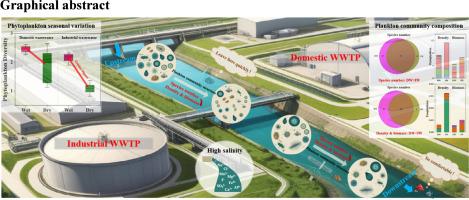Impacts of different types of wastewater discharge on plankton community structure in the receiving rivers of the Yangtze River
IF 7.3
2区 环境科学与生态学
Q1 ENVIRONMENTAL SCIENCES
引用次数: 0
Abstract
The quantities of industrial and domestic wastewater are increasing in the Yangtze River Basin, which may have a significant impact on receiving rivers. Many studies have examined plankton distribution patterns influenced by wastewater treatment plant (WWTP) effluents. However, few have explored how different wastewaters (domestic, industrial, and mixed) affect plankton communities. To address this gap, 92 samples were collected from the receiving rivers within the Yangtze River Basin during various seasons. The results showed that the treated industrial wastewater significantly altered the plankton community structure via elevated salinity, particularly affecting phytoplankton seasonal variation. Phytoplankton numbers during the dry season were more than 10 % higher than those during the wet season, in contrast to trends from other wastewaters. Both plankton (specifically for Bacillariophyta) density and biomass decreased by approximately 36 % following the input of treated wastewater, but increased again 500 m downstream of outfall in both seasons. Industrial wastewater samples exhibited stronger connections among higher taxa and more negative associations between F−, TDS, Cl−, K+, Na+, etc., with various species than those influenced by other wastewaters. Furthermore, ecosystem health levels gradually improved from poor status near the outfall to sub–health status 10 km downstream of the confluence with the mainstream. These findings reveal the impacts of different types of wastewater on plankton communities. Incorporating salinity into regulatory assessment criteria and optimize treatment processes to reduce effluent salinity. This study provides critical guidance into the effects of wastewater discharge on freshwater ecosystem functioning.


不同类型污水排放对长江受纳河流浮游生物群落结构的影响
长江流域工业和生活污水的数量正在增加,这可能对接收河流产生重大影响。许多研究都考察了污水处理厂出水对浮游生物分布格局的影响。然而,很少有人探索不同的废水(生活、工业和混合)如何影响浮游生物群落。为了弥补这一空白,在不同季节从长江流域的接收河流收集了92个样本。结果表明,处理后的工业废水通过提高盐度显著改变了浮游生物群落结构,特别是影响了浮游植物的季节变化。与其他废水的趋势相反,干季的浮游植物数量比湿季高出10%以上。浮游生物(特别是硅藻类)的密度和生物量在处理后的废水输入后均下降了约36%,但在两个季节的排放口下游500 m处再次增加。工业废水样品与其他废水样品相比,高等分类群之间的联系更强,F−、TDS、Cl−、K+、Na+等与不同物种之间的负相关关系更强。此外,生态系统健康水平从出水口附近的不良状态逐渐改善到与干流汇合处下游10 km处的亚健康状态。这些发现揭示了不同类型的废水对浮游生物群落的影响。将矿化度纳入监管评估标准,优化处理工艺以降低废水矿化度。该研究为研究污水排放对淡水生态系统功能的影响提供了重要的指导。
本文章由计算机程序翻译,如有差异,请以英文原文为准。
求助全文
约1分钟内获得全文
求助全文
来源期刊

Environmental Pollution
环境科学-环境科学
CiteScore
16.00
自引率
6.70%
发文量
2082
审稿时长
2.9 months
期刊介绍:
Environmental Pollution is an international peer-reviewed journal that publishes high-quality research papers and review articles covering all aspects of environmental pollution and its impacts on ecosystems and human health.
Subject areas include, but are not limited to:
• Sources and occurrences of pollutants that are clearly defined and measured in environmental compartments, food and food-related items, and human bodies;
• Interlinks between contaminant exposure and biological, ecological, and human health effects, including those of climate change;
• Contaminants of emerging concerns (including but not limited to antibiotic resistant microorganisms or genes, microplastics/nanoplastics, electronic wastes, light, and noise) and/or their biological, ecological, or human health effects;
• Laboratory and field studies on the remediation/mitigation of environmental pollution via new techniques and with clear links to biological, ecological, or human health effects;
• Modeling of pollution processes, patterns, or trends that is of clear environmental and/or human health interest;
• New techniques that measure and examine environmental occurrences, transport, behavior, and effects of pollutants within the environment or the laboratory, provided that they can be clearly used to address problems within regional or global environmental compartments.
 求助内容:
求助内容: 应助结果提醒方式:
应助结果提醒方式:


